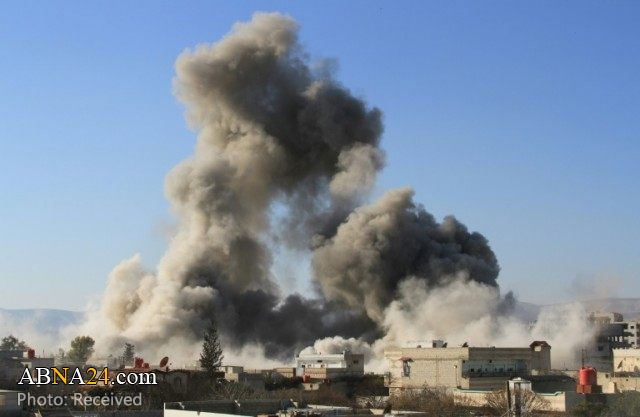(AhlulBayt News Agency) - Several months after the defeat of ISIS and other terrorist groups across Syria and particularly Damascus outskirts in sweeping operations led by the Syrian government forces and backed by the Iran-led Axis of Resistance and Russia, now Syria is ready to see the return of peace and stability to the war-hit regions.
But, on the other side, efforts are underway by the US and the allied parties such as Saudi Arabia and the Israeli regime to see the perpetuation of the crisis, now in its eighth year. Over the past months, Tel Aviv and US-led military coalition launched several airstrikes targeting the Syrian government’s positions across the country. And in the latest development, on June 18, the coalition’s fighter jets bombed the Syrian Arab Army’s positions in Al-Hari town in Abu Kamal near the border with Iraq. According to the news reports, the attack left considerable casualties. Reuters quoted a Syrian government forces commander as saying that the attack was "probably" launched by US drones which were targeting positions of Iraqi factions between Albu Kamal and Tanf and Syrian military positions. The strike reportedly targeted Syrian army and the allied Iraqi Popular Mobilization Forces (PMF) in the region which is located between Abu Kamal and Al-Tanf.
On the heels of the attack, the Pentagon Spokesman Major Adrian Rankine-Galloway issued a statement denying that the attack was by the so-called international anti-ISIS coalition, formed in 2014. But such a drone attack close to a military base where the American forces are stationed strengthens the theory that Washington was behind the bombing. But why does the US strike the Syrian army and PMF base
Cutting Resistance front’s links on Syria-Iraq border
The key drive behind the coalition’s raid in the border city of Abu Kamal is weakening and if possible cutting off the Resistance camp’s links on the two sides of the border. Abu Kamal is one of the largest cities of Deir ez-Zor province with majority of its territory being desert. A route linking Baghdad to Damascus through Abu Kamal and Al-Qa’im border cities provides the key connection line for the Resistance forces moving between Syria and Iraq. Moreover, the region is a key border hub for security, military, and trade exchanges between the two neighbors. Al-Qa’im city in Iraq’s Al-Anbar province was the first Iraqi point to fall to the advancing ISIS fighters in 2014. Abu Kamal, on the other side of the border, was the last region of the major ISIS concentration in Syria liberated by the syrian army in 2017. Following Al-Qa’im and Abu Kamal recapture, the Baghdad-Al-Qa’im-Abu Kamal-Damascus route served as a key supply and transportation line for the Resistance forces moving between the two terror-hit countries. The ISIS defeat opened the door for PMF to deploy forces to the border areas, something represented a source of concern for the Americans who feared the anti-terror camp’s power gain. That is why many analysts hold Washington accountable for the attack, arguing that it is a failed move to sever the Resistance’s contact lines on the two sides of the border.
Empowering ISIS remnants for continued crisis
Over the past few months, ISIS empowerment has been a key strategy the US was pursuing in Syria and particularly in Deir ez-Zor. According to the latest report published by the Russian ministry of defense, the US-controlled areas in the east of the Euphrates River have been safe haven for ISIS remnants. The attack comes only three days after the Syrian army reclaimed 40-kilometer Haql Al-Ward-Faydha Ibn Mowayne highway in Deir ez-Zor’s Mayadin District and cleared the roadside mines planted by the ISIS forces. Americans very likely seek to check more Syrian military advances and give ISIS an upper hand in the area. The ongoing crisis in Syria’s east automatically gives the US the excuse to keep forces on the Syrian soil. On March 30, the US President Donald Trump said American forces will leave Syria “very soon.” But over the past few months, Washington’s actions on the Syrian fronts signaled that they are engaged in hard efforts to pave the way for long-term presence in Syria.
Compensating decline to back Syrian Kurds
The US relations with the Syrian Kurds is not unconnected to the June 18 air raid. The past few months’ developments put these relations on a shaky ground. The US made no move to support the Kurds when the Turkish army earlier this year launched a military campaign to seize the Kurdish-controlled Afrin city in northern Syria. Moreover, Americans recently sealed a deal with Ankara to remove the predominantly-Kurdish Syrian Democratic Forces (SDF) from Manbij, also in the north, moving the Syrian Kurds to believe that Washington is unreliable. Feeling double-crossed, last week the so-called Syrian Democratic Forces (SDF), a predominantly- Kurdish militia backed by the US, in a bold move declared it was ready to talk unconditionally to the Syrian government.
The offer by the US ally was seen as marking an end to Washington’s last base in Syria. Since 2015, the SDF, a coalition of Kurdish militias accompanied by a small number of Arab fighters, played a key role as a US ally, with many analysts calling them Washington’s infantry on the front lines and a power basis for it in Syrian equations. Now, the SDF are turning leaving the US without a major ally in a multi-front, multi-player conflict. A possible central government-Kurds agreement to return Damascus rule to the north and east will be a showcase of US decline to take serious actions to defend its base.
So, the US wants to appease the Kurds by telling them that the east Euphrates is a red line and they will continuously have the coalition’s backing. But the US should be so lucky to bring back the Kurdish Democratic Union Party (PYD) leaders on the track of former cooperation now that they feel betrayed.
/129

